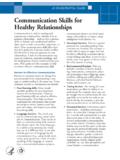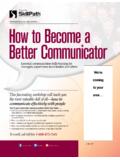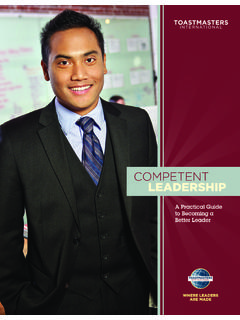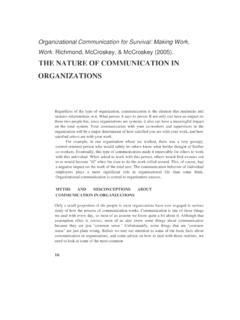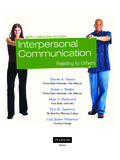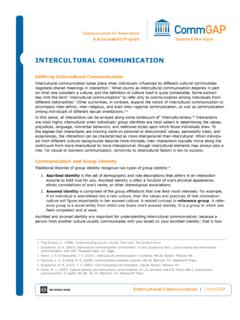Transcription of Communication Skills for Healthy Relationships
1 A WorkLife4 You GuideCommunication is vital in creating and maintaining a relationship, whether it be an intimate relationship such as with a partner, child, or friend or a professional relation-ship such as with a co-worker, supervisor, or client. Your Communication Skills affect how you solve problems, how you resolve conflict, and the level of trust you generate in your Relationships . A lack of Communication may result in confusion, misunderstandings, and the development of poor Communication pat-terns. This guide provides strategies to help you foster effective Communication to Effective CommunicationBarriers to Communication are things that prevent people from understanding a mes-sage, or understanding it the same way. Some common barriers to Communication include: Poor listening Skills . Many people consider speaking the most important element of Communication .
2 However, good listening Skills are critical to effective Communication . They help you better understand the information other people are trying to convey, improve your rap-port with others, and improve your prob-lem solving Skills . Language barriers. The words you use to communicate may create a bar-rier to Communication . This can be as basic as communicating with someone who doesn t speak the same language, or a subtle as interpreting the words you use in a different way. It can also include poor use of language by the communicator ( , using words incor-rectly, poor grammar), a lack of under-standing of the language or context ( , a non-technical person trying to Communication Skills for Healthy Relationshipscommunicate about a technical issue), using colloquialisms or jargon, using ambiguous word choices, etc. Emotional barriers. There is a greater potential for misunderstanding when emotions are involved.
3 For example, a sender who is upset or angry may not be able to effectively communicate his or her feelings and ideas. A receiver in a similar state may ignore or distort what the other person is saying. Environmental barriers. This can include a number of factors includ-ing, interruptions, distractions, physi-cal environment issues (lighting, noise, comfort), talking too softly, physical distance, a physical barrier between sender and recipient, etc. Timing barriers. The timing of a com-munication can affect it s ability to be understood. For example, there may not be enough time to communicate the mes-sage fully, or it may be too early or too late in the day for someone to give the Communication his or her full attention. Perceptual barriers. Each person experi-ences events including communica-tions in a way that is unique to him or her. A sender will communicate in a way that makes sense in his or her reality.
4 A receiver understands a Communication in a similar manner. However, these two realities may not be the same, so the mes-sage may be perceived differently, hinder-ing Communication . Variables includ-ing age, education, gender, social and economic status, cultural background, temperament, health, religion, politi-cal beliefs, etc. can alter perceptions and create barriers to Communication . Filtering. Think of the child s game of telephone, where a message is passed from one person to another. In most cases, the message, as finally received, is very different from the one that was originally sent. That is filtering. Filtering occurs in a variety of ways that can be a barrier to effective communi-cation, for example, when an assistant, co-worker or spouse takes a message on your behalf, how someone leaves a mes-sage on an answering machine, involves hearing and paying atten-tion to the speaker.
5 However, hearing and effective listening are very different abili-ties. Consider the following tips to help you become a more effective listener: Clear your mind to avoid wandering mentally. Your internal dialogue deciding what you want to say, react-ing to something the other person said, other issues that may be on you mind can distract you from actively listening to the other person. Focus on what the other person is saying. Give the other person your full attention and listen carefully to what he or she is saying. Think of this as a opportunity to learn something about the other person. Don t interrupt. Allow the other per-son to talk without interruption until he or she gets to the point. Use body language to indicate your interest and attention, and encourage the other person to speak: Keep up good eye contact. Lean forward, nod your head, make encouraging gestures.
6 Keep your body relaxed, open and focused on the speaker. Avoid crossed arms and legs, clenched fists, turning the eyes/head/body away or being easily distracted; this indicates disinterest or opposition. Avoid distracting behaviors, such as play-ing with a pencil, drumming your fin-gers, jingling change in your pocket, etc. These make it difficult for you to listen and distract the speaker. Use acknowledging responses such as uh-huh, I see, you don t say, okay, etc. These encourage the other person to speak and show that you are interested in what he or she is saying. Paraphrase what you believe the other person has said. This will indicate that you have been listening, and ensure that your understanding is accurate. At the end of the conversation you may wish to summarize the discussion, as well. Ask questions. Don t interrupt, but at an opportune time clarify anything that seems unclear to you.
7 Pay attention to the speaker s non-verbal messages, by observing tone of voice and body language. This can give clues as to what the other person is thinking and feeling and how he or she is responding to what you say. Respond constructively. Let the other person know you value what he or she is saying, even if you don t agree. Try to avoid responding negatively or directively, for example criticizing, ridiculing, dis-missing, diverting (talking about your-self rather than about what the other person has said) or rejecting the other person or what they are saying. Respond appropriately. Make sure you clearly understand what the other person wants from you and respond appro-priately. If you aren t certain what the other person wants, ask for clarification. Try to avoid giving unwanted diagnosis, advice or direction unless the person specifically requests it from you.
8 For example, if a friend or co-worker simply wants to vent about an incident that frustrated him, he may not appreciate you giving unwanted advice about how you feel he or she should have handled the situation. SpeakingThe goal in speaking is to convey a message to another person so that the other person understands it exactly as you intended it. The following strategies can help you sharpen your verbal Communication Skills . Make certain you have the other per-son s attention. When you have some-thing important to say to somebody, make sure you have his or her attention (call him or her by name, make eye con-tact) before you begin talking. Be organized. Have an objective and structure your speaking towards that goal. Think before you speak and pres-ent your thoughts/information in an organized manner. Use I phrases such as I feel .., I need .., or I would like.
9 As opposed to you did .., you are .. I statements focus on your feelings, are less accusatory, create less defensive-ness, and help the other person under-stand your point of view rather than feeling attacked. Speak so the listener will understand. Avoid jargon, colloquialism, overcom-plicated terminology, etc. Speak in a way that is appropriate for the age, sex and emotional state of the other person. Encourage open-ended conversation. Use open-ended questions that promote a response, such as tell me about .. how do you feel Avoid ques-tions that encourage a one word answer. Be open. Share your feelings truthfully .. but respectfully. Approach the dis-cussion as an opportunity for the other person to learn something about you. Be specific and objective. Identify the specific issue at hand and how it makes you feel. Avoid generalizing statements such as always, ever or never.
10 Stick to the subject; try not to digress into broad personality issues or revive past issues. Be positive. Focus on the other person s positive points. Be specific, generous and public with your praise. Make sure that positive feedback outweighs criticism. Respond, but don t react. Be respect-ful, calm and positive. If the discussion is escalating into anger, take a short break from it. Agree on a set time to resume the discussion and be sure that you do. Ask for a summary. Find a polite way of ensuring that people have understood you. Could you summarize what we ve discussed to make sure we are on the same page? Could you review the major deliverables to make sure that I m going in the right direction. Try to resolve conflicts, not to win them. If you are unable to initially come to an agreement, take a break and set a time to try again. Try to develop a solution to the problem but remember, occassionally you may have to agree to disagree.
